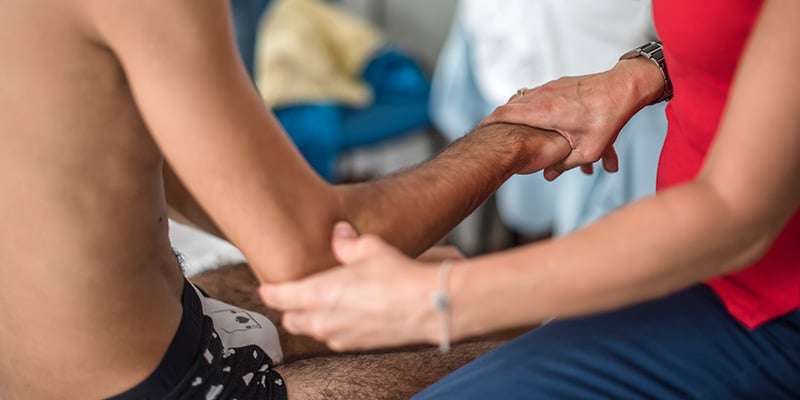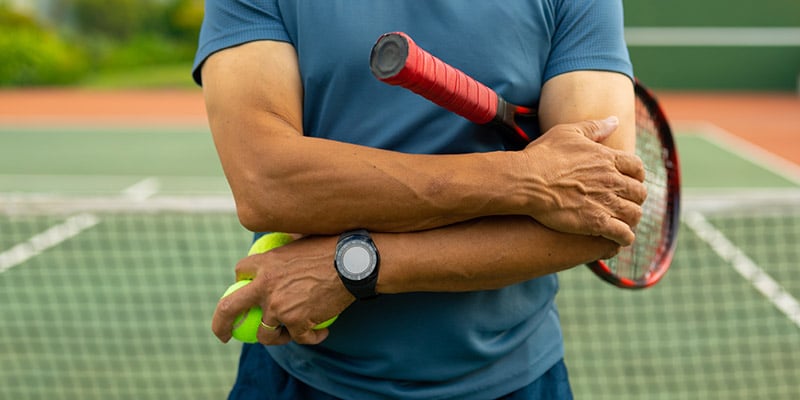6
What is Tennis Elbow
Last Updated: November 5, 2024

Table of Contents
Lateral epicondylitis, commonly known as tennis elbow, is a painful condition of the tendons of the elbows. It can range from a gentle ache to severe pain and has many causes.
Key Takeaways
- Definition: Tennis elbow, or lateral epicondylitis, is a condition caused by overuse of the forearm muscles, leading to pain around the elbow.
- Causes: Repetitive motions, especially in sports or activities like tennis, are common triggers.
- Symptoms: Includes pain and tenderness on the outside of the elbow, which can worsen with grip-related activities.
- Diagnosis: Typically involves a physical exam and assessing pain response during movement.
- Treatment: Rest, physical therapy, and anti-inflammatory treatments are common.
- Prevention: Strengthening exercises and proper technique can help prevent recurrence.
Definition Of Tennis Elbow
Lateral epicondylitis or a tennis elbow is a condition of the lateral epicondyle - the outside of the elbow - characterized by pain and inflammation of tendons. Injured tendons, injured or excessively tight forearm muscles, or traumatic injuries are often to blame for tennis elbow. It is often seen in athletes, desk workers, and people performing repetitive arm movement tasks.
Golfer’s Elbow And Related Conditions
Tennis and golfer’s elbow are similar conditions with similar causes but different pain points. While tennis elbow is lateral epicondylitis, golfer’s elbow is medial epicondylitis. Lateral epicondylitis (tennis elbow) affects the outside portion of the elbows, while medial epicondylitis (golfer’s elbow) affects the inside. Symptoms, causes, and treatments are very similar and can be present simultaneously. Lateral epicondylitis is more common.
Symptoms of Tennis Elbow
Depending on the severity of tennis elbow, symptoms can range from easily-ignored dull aches to a debilitating searing sensation. Tennis elbow is often classified as either a traumatic injury - an injury caused by a single event - or as an overuse injury - an injury caused by repetitive tasks over weeks, months, or years. The symptoms differ slightly between pathologies.
General Symptoms
Most cases of tennis elbow, regardless of cause, have some general symptoms.
- Pain on the outside of the elbow
- General tenderness above and below the elbow
- Pain in the forearm just below the elbow
Traumatic Injuries
In the case of a traumatic tendon injury, a sudden onset of symptoms may include:
- Searing pain on the outside of the elbow
- Swelling or inflammation
- Pain while performing certain tasks
- Loss of ability to bend at the elbow
Overuse Injuries
- Gradual onset of dull pain
- Reduced range of motion at the elbow
- Pain or aching after performing certain motions, like holding a coffee cup or opening a pickle jar
Tendinitis vs. Tendinosis
Tennis elbow is tendinitis, an inflammation where the tendon attaches or crosses the elbow joint. Tendinosis occurs when small tears in the tendon form scar tissue and cause painful symptoms over time, often resulting from degeneration.
Tennis elbow is normally diagnosed as tendinitis, but in the case of symptoms developing from repetitive motions, it is more likely to be tendinosis. Treatments vary slightly depending on the cause of the injury, with tendinitis being treated with rest and anti-inflammatory processes and tendinosis often needing a more long-term care solution.
Causes of Tennis Elbow

Despite its name, tennis elbow is frequently seen in people who don’t play tennis or other racquet sports. Tennis players often get tennis elbow from performing a poorly-executed backhand stroke or using improper equipment. Workers or athletes in other sports can get tennis elbow from a repetitive movement of the elbows when performing any number of tasks.
Work-related Causes
Many jobs require repetitive arm movements. Desk workers, assembly line staff, tradespeople, food service workers, and more are often subject to the forces that cause tennis elbow. Workers can get tennis elbow from holding a tool for long periods at work, causing the wrist muscles to get tight and sore. A server carrying trays of food, an electrician installing lightbulbs, and an accountant spending hours inputting data on a keyboard may all experience inflammation of the wrist extensors, elbow tendons and arm muscles leading to symptoms. Causes include:
- Long periods of holding or manipulating tools
- Carrying heavy loads with a bent arm
- Frequent twisting of the wrist
- Long periods of typing/hand movements without breaks
Activity and Exercise
While it is common in tennis players, racquet sport isn’t the only activity or exercise-related cause of tennis elbow. Many forms of activity are risk factors for tennis elbow. Added stress on or around the elbow joint, shoulder joint, or wrist can lead to tennis elbow. Strength sports athletes, baseball players, lacrosse players, and athletes of many disciplines often develop tennis elbow.
- Repetitive stress to the elbows
- Improper sports equipment (like a wrongly sized or too tightly-strung tennis racket)
- Improper technique for weight training
- Insufficient flexibility at the shoulder (in the case of barbell squats or bench press aggravating the elbow)
Genetic and Developmental Factors
Some people have a predisposition to developing golfer’s or tennis elbow. Age, level of arm and forearm strength, a tendency toward inflammation, or an injured tendon or other injuries may all increase the chances of someone developing tennis elbow symptoms. Weak or under-developed forearm, wrist, upper arm, and shoulder muscles increase the likelihood of developing tennis elbow. For these reasons, strengthening exercises are often prescribed to prevent tennis elbow in people at higher risk.
The Complex Physiology Of The Elbows
The elbows are not simple hinge joints; they are also responsible for supination - turning the palm upward. Because of its multidirectional movement, many muscles cross the elbows at different angles to provide motion. The biceps, triceps, forearm muscles, wrist flexors and extensors all attach near the elbows, meaning pinpointing a specific problem muscle or tendon can be difficult.
Some of these muscles and tendons attach on the lateral epicondyle - the bony bump on the elbow's outer (lateral) side at the bottom of the humerus (the upper arm bone). Pain here is tennis elbow. A similar bump on the inside, the medial epicondyle, is responsible for golfer’s elbow. It’s important to have tennis elbow diagnosed by a professional to find the root cause of the pain. Orthopedic surgeons, physical therapists, and sports medicine doctors are best equipped to identify, diagnose, and provide treatments for tennis elbow.
Preventing Tennis Elbow
As they say, an ounce of prevention is worth a pound of cure. Implementing some easy strategies to prevent tennis elbow is much easier than fixing the problem once it has developed. Some strategies to prevent lateral epicondylitis from developing include:
- Taking frequent breaks from repetitive work tasks
- Regularly performing stretching exercises for the upper and lower arm
- Stretching and strengthening the forearm
- Physical therapy to rehab any existing shoulder or wrist injuries
Treatments For Elbow Pain

There are several ways to treat tennis elbow; the treatment used will depend on the severity of symptoms and underlying cause. More conservative treatments, like icing, stretching, and strengthening, are often enough to reduce pain from mild instances of tennis elbow. Serious cases may need steroid injections or surgery, but nonsurgical treatments are always the first step. There are dozens of methods to treat the symptoms of tennis elbow, including:
- Physical therapy exercises to gain or regain muscle strength in the arm muscles.
- Stretching exercises to fix faulty movement patterns at the arm or shoulder
- Muscle stimulation techniques (TENS machines)
- Joint flossing to increase blood flow and break down scar tissue
- Tennis elbow surgery to repair tendons
- Platelet rich plasma (PRP) injections to promote healing
- Steroid injections to reduce inflammation
- A special brace to prevent the elbow from moving in ways that cause pain
- Extracorporeal shock wave therapy (therapy with sound waves) to break down scars and promote healing
- Activity modification, avoiding the things that cause stress on the elbows
It’s important to remember that treating the symptoms of tennis elbow doesn’t fix the root cause. In the long run, the best option to reduce pain is to consult a professional and find the underlying issue.
Pain Referrals and Non-Specific Pain Around The Elbows
Elbow or arm pain is often caused by issues outside of the elbows. Due to how many muscles and tendons cross the elbow joint, it’s common for arm, wrist or shoulder issues to manifest in a pain referral at the elbow. Always consult a physical therapist or other healthcare professionals before treating elbow issues.
Frequently Asked Questions
I’ve Never Touched A Tennis Racket! Could I Still Have Tennis Elbow?
Yes! That pain on the outside of your elbow could be caused by dozens of factors, even everyday tasks. Despite its oddly specific name, anyone can get tennis elbow.
How Do Professionals Diagnose Tennis Elbow?
Sometimes orthopedic surgeons will use magnetic resonance imaging (MRI) to look for issues in the tendon. Still, most diagnoses start with a physical exam, palpating, and manipulating the arm to find what causes pain. In some cases, x-rays and ultrasounds are also used.
Will I Need Surgery To Fix My Symptoms?
Probably not. Surgery is only needed in rare, extreme cases. Nonsurgical treatment is normally enough to heal the elbows.
How Can I Tell The Difference Between Tendinitis and Tendinosis?
It’s tough to self-diagnose pain on the outside of your elbow. A conservative treatment like icing or anti-inflammatory drugs is normally enough to resolve the issue if a tendon is inflamed. In more serious cases when a tendon has torn or scarred, these at-home treatments often don’t cut it. Regardless of whether you think you have tendinitis or tendinosis, if the pain persists or worsens after several days, you should see a medical professional.
References
Lateral Epicondylitis (Tennis Elbow) | Johns Hopkins Medicine
Difference Between Tendinitis and Tendinosis
THE PATHOLOGY AND TREATMENT OF TENNIS ELBOW: JBJS
Tennis Elbow | Bone and Joint Journal
Extensor carpi radialis brevis muscle - Wikipedia
The etiology and treatment of tennis elbow
Tennis elbow: conservative, surgical, and manipulative treatment. - PMC
Anatomic Factors Related to the Cause of Tennis Elbow
Tennis Elbow Symptoms and Causes | Mayo Clinic
Disclaimer
The contents of this article are provided for informational purposes only and are not intended to substitute for professional medical advice, diagnosis, or treatment. It is always recommended to consult with a qualified healthcare provider before making any health-related changes or if you have any questions or concerns about your health. Anahana is not liable for any errors, omissions, or consequences that may occur from using the information provided.

Dr. Darlene Buan-Basit is a highly experienced licensed Chiropractor and Pilates instructor with expertise in many techniques, including Medical Acupuncture, Traditional Chinese Medicine, and Advanced Massage Techniques.
